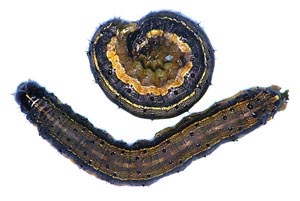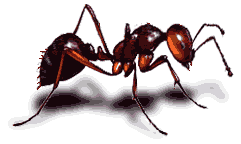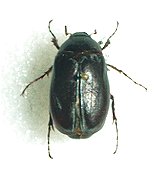The lawn is an ideal environment for a number of insects and related creatures. Some of these animals may be classified as pests; however, many are harmless, and some are beneficial. You should be able to tell the damaging ones from the non-injurious types. This can be difficult, because insect damage may be mistaken for disease, drought, or fertilizer problems. To make sure you need a pesticide, you must first "scout" for pests to see if there are enough to justify the treatment. If you do treat, you need to make sure you apply the pesticide correctly and at the right time. To help you correctly recognize pests, here are descriptions of common lawn insects.

Chinch Bugs
Chinch bugs are damaging pests to St. Augustine grass. They have occurred on grasses such as zoysia, bermuda, and centipede, but these infestations usually occur where high populations have built up on St. Augustine grass. As the insect sucks the plant juices, it releases a toxin that causes yellowish-brown patches to appear in lawns. If the feeding does not kill the grass, it recovers slowly and the lawn looks bad for a long time. The chinch bug is a sunshine-loving insect and seldom attacks grass in shaded areas.
Chinch bugs are about one-fifth of an inch long. They are black with white wings that are folded over the back. The small nymphs or young chinch bugs are about one-twentieth of an inch long. They are bright red with a white band across their backs.
Check your lawn weekly in the warm months of the year. Part the grass in several locations and watch for the insects as they move into the thatch. You can also cut the bottom from an opened fruit can, imbed it 2 to 3 inches deep in a green area adjacent to damaged turf, and fill it with water. If chinch bugs are present, they float to the top after 5 to 10 minutes.

Fall Armyworms
The fall armyworm is damaging during the larval, or worm, phase. It uses chewing-type mouthparts to defoliate the grass blades. You should be on the lookout for this pest, especially if you have bermudagrass, around the first or second week of June. During high outbreak years, it may feed on centipedegrass or St. Augustinegrass; however, this is rare.
Fall armyworm adults (moths) are active at night. At this time, the female deposits egg masses containing about 150 eggs on grass stems. Females can lay 1,000 eggs. After hatching, the young larvae feed as a group on the grass blades. The damage at this stage is slight and often goes unnoticed by the homeowner. As the larvae increase in size, they require more food and can strip a lawn in a short time. To prevent this, make regular lawn inspections during this time of year.
Select locations at random throughout the lawn, and examine the grass by rubbing it back and forth with your hand; then part the grass and examine the ground. If you see a coiled light-tan or green to nearly black caterpillar, you probably have fall armyworms. Control is much easier if you find worms early; you also keep lawn damage to a minimum.

Fire Ants
Fire ants are a nuisance and sometimes a painful pest to lawn and turf owners. It is unlikely we will eradicate this pest any time soon, but with good management, we can remove the problem associated with it. This involves reducing its populations to tolerable levels by using safe and effective methods of control.
The most successful practice for fire ant control on lawns and turf is to use granular baits in the early spring, followed by soil drenches 3 to 4 weeks later. Early spring application is ideal, because it controls newly developed queens before they leave on their nuptial flights and establish new colonies. Killing, or somehow neutralizing the queens, is the only way to eliminate fire ant colonies. Follow-up applications usually are necessary in midsummer and in the fall.

June Beetles
The larval form of this insect, commonly referred to as white grubs, can damage most turfgrasses. The grub feeds below ground on roots, causing the grass to yellow. You can easily lift damaged sod by hand from the ground.
The adult is light brown to black with a reddish tinge behind its head. Flights occur from late April to early May in and about mid-May. The grub is white except for the last two segments of the abdomen, which are dark gray. When found in soil, it is rather inactive and will be curled in the shape of a "c."

Mole Crickets
This insect feeds on grass roots. Adult mole crickets are light brown, often tinged with green. The front legs are short with shovel-like feet well adapted for digging. The young, or nymphs, are identical to the adult except smaller. Infestations may first be detected by walking across areas that have a feel of fluffiness to the sod. Closer examination reveals holes in the ground about the size of a pencil, burrowing trails, and damaged root systems. The adult and nymphs can be damaging.
To check for this insect, use 1 ounce of liquid dishwashing soap to 2 gallons of water. Pour this solution slowly over about 4 square feet of the suspected area. If mole crickets are present, they will crawl to the soil surface.


Snails and Slugs
These creatures do not damage turf, but they can be annoying. These pests, which are not insects, leave a trail of viscous material that appears as a silver trail when dry. They can damage bedding plants by feeding on young, tender leaves. Snails are about 1 inch long with spiral shells. Slugs can vary in length from half an inch to 4 inches. They look like snails except they do not have the shells on their backs.
Snails and slugs are active at night. During the day, they can be found under mulch, in grass along sidewalks or patio edges, or under any object that may be in the lawn.

Sod Webworms
Sod webworms are the larval, or worm, stage of a small night-flying moth. The moth is about three-fourths of an inch long, cigar shaped, and gray. It has two noticeable finger-like projections on the front of the head. You may see it during the day while mowing or walking across the lawn. The moth flies short distances in a zig-zag pattern before settling quickly back into the grass.
The webworm larvae generally feed at night and prefer areas that receive plenty of direct sunlight during the day. Problems seldom develop in shaded areas. During the day the larvae may be found in small silken tunnels in grass thatch. They feed on grass blades next to these tunnels by clipping it off at the thatch line. Injury appears as small brown patches about the size of a softball. This insect attacks bermudagrass and zoysiagrass.

Ticks and Fleas
Fleas and ticks are carried from lawn to lawn by dogs and cats. They are blood feeders and bite people. Ticks have an extremely high reproductive potential. For example, one adult female, depending on type, may lay as many as 3,000 to 5,000 eggs in 2 weeks. These take about 35 to 40 days to hatch. After hatching, the young ticks tend to climb and may climb up grass, shrubs, or sides of the house.
Adult fleas feed on blood, while the larvae feed on bits of organic material or dried blood in and around bedding areas. If not controlled on the pets, infestations of fleas can reach high levels.
Control
Controlling lawn pests depends on getting the insecticide to the target. Insects (such as white grubs and chinch bugs) feed at or below the soil line. It is important in situations like these to use enough water to insure penetration. This often calls for using 15 to 20 gallons of water per 1,000 square feet. A hose-on-type of sprayer is ideal for applying this much water. If you can apply materials only in small volumes of water, mow the grass first and thoroughly water the affected area before applying insecticides. Granular materials are heavy and settle deep into the thatch; however, watering after application insures good penetration.
To control lawn pests, first determine which pest is involved then select one of the insecticides from the chart. When using one of these materials, be sure to use good safety practices. Keep these points in mind:
- Pick up containers that may be used for feeding or watering pets before making the applications.
- Let the area dry before using it for outside activities.
- Use correct rates. This calls for measuring the material (tablespoons or ounces) as you put it into the sprayer. Guessing is not good enough.
- Check the label for information that will help you get the desired results--safe insect control.
Regardless of the pest, the best way to minimize damage is through prevention:
- Keep turf healthy through proper mowing, watering, and fertilizing. Healthy turf will tolerate more pests.
- Plant the right grass for your location. Choose grasses that resist pests, such as endophytic varieties of perennial ryegrass and fine leaf and tall fescues. (Endophytes are beneficial fungi that live on the grass and discourage surface feeders.)
- Scout before you treat. If you use pesticides, treat when the pest is most vulnerable, and follow all directions carefully. To prevent water pollution, never apply pesticides when ground is frozen or saturated. To prevent drift and volatilization (which releases pesticides into the air), do not apply when temperatures are high or it is windy.